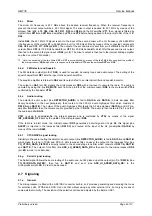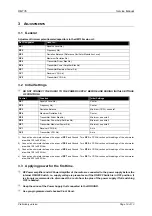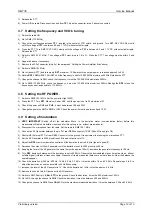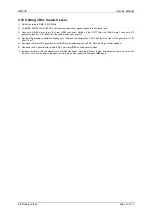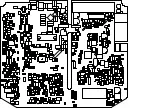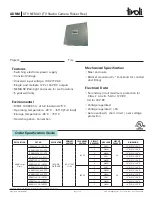
HM135
Service Manual
Preliminary version
Page 9 of 13
The microprocessor manages the analogue switches for the scrambler as well, which is base-band-inversion type.
2.7.b
CTCSS (Continuous Tone Coded Squelch System)/DCS (Digital Coded Squelch)
CTCSS signals and DCS signals are synthesized by the microprocessor
DD5
(pin
39
- line
MCU_CTCSS_DCS_PWM
) and appear as PWM, then smoothed by the CTCSS/DCS 300 Hz low pass filter which
consists of
DA9:A
and related circuitry to produce an acceptable sine wave output. The output of the filter is fed in
the pin
2
of the IC
DA10
which adjusts the level and outputs the regulated CTCSS/DCS at its pin
12
. This signal is
then applied to the second input of
DA9:C
in order to be summed with the speech/Selcall signal.
The CTCSS/CTS decoding is provided by the microprocessor
DD5
(pin
60
) which gets the proper signal from the
detector as explained in par. “CTCSS/DCS signal routing”.
2.7.c
Selective call (Selcall) encoder
Similarly to CTCSS/DCS, Selcall signals are also generated and decoded by the microprocessor
DD5
. Selcall
encoding audio PWM signaling coming from the pin
37
of the microprocessor (line
MCU_SELCALL_PWM
) is fed
to the 3 KHz low pass filter which consists of
DA9:B
and related circuitry. Its output is then fed to the input of the
DA11:B
, so routed the same way of the speech audio.
The speech/Selcall signal is applied to the input of
DA11:B
which limits the peak-to-peak output, then is fed to the
pin
3
of IC
DA10
which is a double digital audio regulator. After the level regulation, the speech/Selcall is output at
pin
11
and sent to the first input (pin 9) of
DA9:C
in order to be summed with the CTCSS/DCS signal.
The Selcall decoding is provided by the microprocessor
DD5
(pin
59
) which gets the proper signal from the
detector as explained in par. “Selcall signal routing”.
2.8 ON/OFF switch, rear connector and internal connectors
2.8.a ON/OFF
switch
The line ON/OFF_SWITCH is normally pulled up by the resistor R182. When the front ON/OFF switch is switched
on, this line becomes low, so the zener VD32 can bias the transistor VT35 which activates the main electronic
power ON/OFF switch
VT33
which feeds the main voltage to the regulators
DA7
(+8V) and
DA8
(+5V). The diode
VD37
acts as a typical protection against polarity inversion.
2.8.b Rear
connector
The rear connector
XT3
accomplishes a variety of connections and functions allowing to connect the radio to
many kinds of devices. For example:
Pins
3
and
16
(lines
EXT_SPEAKER-
and
EXT_)
can be connected to an appropriate external speaker
The line
AUX_OUT_FROM_MPU
coming from the pin
16
of the main microprocessor
DD5
drives the transistor
VT33
which
can switch ON/OFF by software a 5,6 V voltage at pin
1
(line
AUX_OUT
) of
XT3
is an auxiliary output programmable by
firmware.
The pin
13
of
XT3
duplicates the hang up function normally provided by the microphone hang up: grounding or not the line
HUNG_UP
reflect a status change in the line
HANG_UP_TO_MPU
via the zener
VD27
and the transistor
VT29
Pin
9
duplicates the PTT connection normally provided by the microphone connector in the front panel. Its line
EXTERNAL_PTT
drives the zener
VD30
and the transistor
VT32
which reflect a status change in the line
PTT_TO_MPU
2.8.c
Internal connectors (accessory board)
The internal connectors
XP1
and
XP2
are used to internally fit a variety of option boards, such as scrambler
modules, audio processing modules etc. For this reason there are many contacts in parallel with
XT3
, e.g.
XP1
has
AUX_OUT
at pin
13
and
EXTERNAL_PTT
at pin
1
. Moreover, the two connectors have other specific lines in
order to handle a large number of internal signals, e.g. flat unsquelched RX audio at pin
14
pf
XP1
and
microphone input/output at pins
1
and
2
of
XP2
.
Summary of Contents for HM135
Page 14: ...ALAN HM 135 TEST POINTS AND PCB LAYOUTS...
Page 16: ...p d f M a c h i n e b y B r o a d G u n S o f t w a r e...
Page 17: ...p d f M a c h i n e b y B r o a d G u n S o f t w a r e...
Page 18: ...p d f M a c h i n e b y B r o a d G u n S o f t w a r e...
Page 19: ...p d f M a c h i n e b y B r o a d G u n S o f t w a r e...
Page 20: ...p d f M a c h i n e b y B r o a d G u n S o f t w a r e...
Page 21: ...p d f M a c h i n e b y B r o a d G u n S o f t w a r e...
Page 22: ...p d f M a c h i n e b y B r o a d G u n S o f t w a r e...
Page 23: ...p d f M a c h i n e b y B r o a d G u n S o f t w a r e...
Page 24: ...p d f M a c h i n e b y B r o a d G u n S o f t w a r e...
Page 25: ...p d f M a c h i n e b y B r o a d G u n S o f t w a r e...
Page 26: ...ALAN HM 135 ELECTRICAL DIAGRAMS...
Page 27: ...HM135_HEAD_FEB_14_2004 SCH p d f M a c h i n e b y B r o a d G u n S o f t w a r e...
Page 28: ...12 13 14 D 5 6 7 B 10 8 9 C p d f M a c h i n e b y B r o a d G u n S o f t w a r e...
Page 32: ...p d f M a c h i n e b y B r o a d G u n S o f t w a r e...
Page 33: ...1 2 3 4 8 A p d f M a c h i n e b y B r o a d G u n S o f t w a r e...
Page 34: ...5 6 7 B p d f M a c h i n e b y B r o a d G u n S o f t w a r e...
Page 35: ...5 6 7 B 10 8 9 C 1 2 3 A 12 13 14 D p d f M a c h i n e b y B r o a d G u n S o f t w a r e...
Page 36: ...p d f M a c h i n e b y B r o a d G u n S o f t w a r e...
Page 37: ...ALAN HM 135 EXPLODED VIEW AND PART LIST...
Page 38: ...ALAN HM 135 PROGRAMMING MANUAL...








